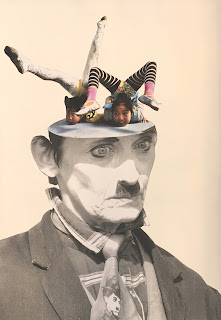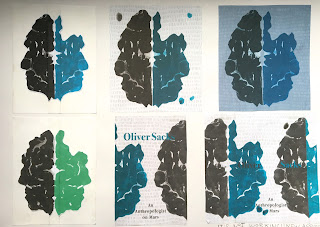This was the first Visual Language workshop brief that I have really got intend enjoyed. I love using collage as a medium and having used it a lot last year it was really nice to come back to.
What went well?
- I think that using a repeat motif worked well because it created a sort of narrative, which runs through the whole book.
- I also think that working really simply, each time just making a tiny change to my image worked really well rather than filling my pages with lots of interacting forms. This is because it created a focus to my book and showed how easy it can be to create simple and effective illusions with collage.
- I also think that using a black and white motif worked well because it allowed me to animate it with a bit of colour if I chose as wall as casting the focus onto the alteration rather than the man himself.
What challenges did I face?
- I enjoyed using the same repeated motif for the first two pages, after which I found it quite limiting. I kept coming up with cool ideas for interesting landscapes and things that I could do with the whole figure (which couldn’t be applied to my man). However, I think that keeping with my motif really forced me to push my ideas and to do things that I wouldn’t have done had I had the freedom to do whatever I wanted. I.e. ripping up the face (which turned out to be one of my most interesting ideas).
- I also found that even though my collages were so simple, it was a very time consuming media to work with. I also tend to work things out while I draw rather than before. However, with collage I found that you can’t do this. You need an idea of what you want to achieve or test out before you start working. I struggled with this at the start but towards the end of my book I found that it started to work well for me.
What could I have done differently and how am I going to move forward?
- I think that maybe I could have been more experimental in the way that I worked rather than so neat and precise. However, I personally was really drawn to the simplicity of my more graphic pieces.
- Even though the man that I used on my motif is from the circus, I don’t think that there is a very circusy feel to my book. I think that maybe I could have worked harder to bring in this element.
- Having enjoyed this workshop so much I want to start bringing elements of collage into my Visual Narratives module. It could be interesting to have small elements of collage in my illustrations for my book (particularly as it is a project based on documenting and recording real world events).














































